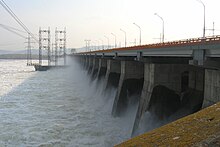Zhiguli Hydroelectric Station
| Zhiguli Dam | |
|---|---|
 |
|
|
Location of Zhiguli Dam in Russia
|
|
| Official name | Жигулёвская ГЭС |
| Location |
Zhigulyovsk Russia |
| Coordinates | 53°25′36″N 49°28′44″E / 53.42667°N 49.47889°ECoordinates: 53°25′36″N 49°28′44″E / 53.42667°N 49.47889°E |
| Construction began | 1950 |
| Opening date | 1957 |
| Owner(s) | RusHydro |
| Dam and spillways | |
| Type of dam | Embankment dam |
| Impounds | Volga River |
| Height | 52 m (171 ft) |
| Length | 2,800 m (9,200 ft) |
| Width (base) | 750 m (2,460 ft) |
| Spillway capacity | 40,000 m3/s (1,400,000 cu ft/s) |
| Reservoir | |
| Creates | Kuybyshev Reservoir |
| Total capacity | 57.3 km3 (13.7 cu mi) |
| Surface area | 6,450 km2 (2,490 sq mi) |
| Max. water depth | 41 m (135 ft) |
| Power station | |
| Turbines | 8 × 115 MW 4 × 120 MW 8 × 125,5 MW |
| Installed capacity | 2,404 MW |
| Annual generation | 11,705GWh |
The Zhiguli Hydroelectric Station or Zhigulyovskaya Hydroelectric Station (Russian: Жигулёвская ГЭС, Zhigulyovskaya GES), formerly known as Kuybyshev Hydroelectric Station (Kuybyshev GES) is a large dam and hydroelectric station on the Volga River, located near Zhigulyovsk and Tolyatti in Samara Oblast of Russia. It is the sixth stage of the Volga-Kama Cascade of dams, and the second of them by installed power.
Construction started in 1950 and was completed in 1957. The complex consists of earth-fill dam, 2800 m long, 750 m wide and 52 m high, concrete spillway dam, 980 m long, power plant house, 700 m long, and two-lane navigable locks. Installed power is 2372,5 MW, average annual production is 11,700 GWh. The power house has 20 generator units with Kaplan turbines, 11 of 115 MW, 4 of 120 MW and 5 of 125.5 MW at 22.5 m head. The dam forms Kuybyshev Reservoir.
The station covers peak loads and maintains frequency stability in the unified power system of Russia (UES), controls flood and maintains navigable waterway. Lower hydroelectric stations are utilised more effectively because of seasonal and over-year regulation provided by the dam. Energy produced by station is transferred by four 500 KV lines - two of them to UES of central Russia and two to UES of the Urals and the Middle Volga.
The idea of hydroelectric station on the Volga near Samara Bend was proposed by Gleb Krzhizhanovsky in 1910. Ten years later K. V. Bogoyavlensky proposed a hydroelectruc station near Perevoloki, utilizing naturally existing water level difference. The disrupted economic system of the time did not allow this project to be realized.
In the early 1930s the Volga near Samara Bend and Yaroslavl was surveyed, and some dam projects were proposed. In 1937 the project of a dam near the villages of Perevoloki and Krasnaya Glinka was approved. Forced labour from Kuybyshev Camp was used (up to 40,000 people). In the autumn of 1940, oil fields were found near construction site, causing a suspension of construction.
...
Wikipedia

